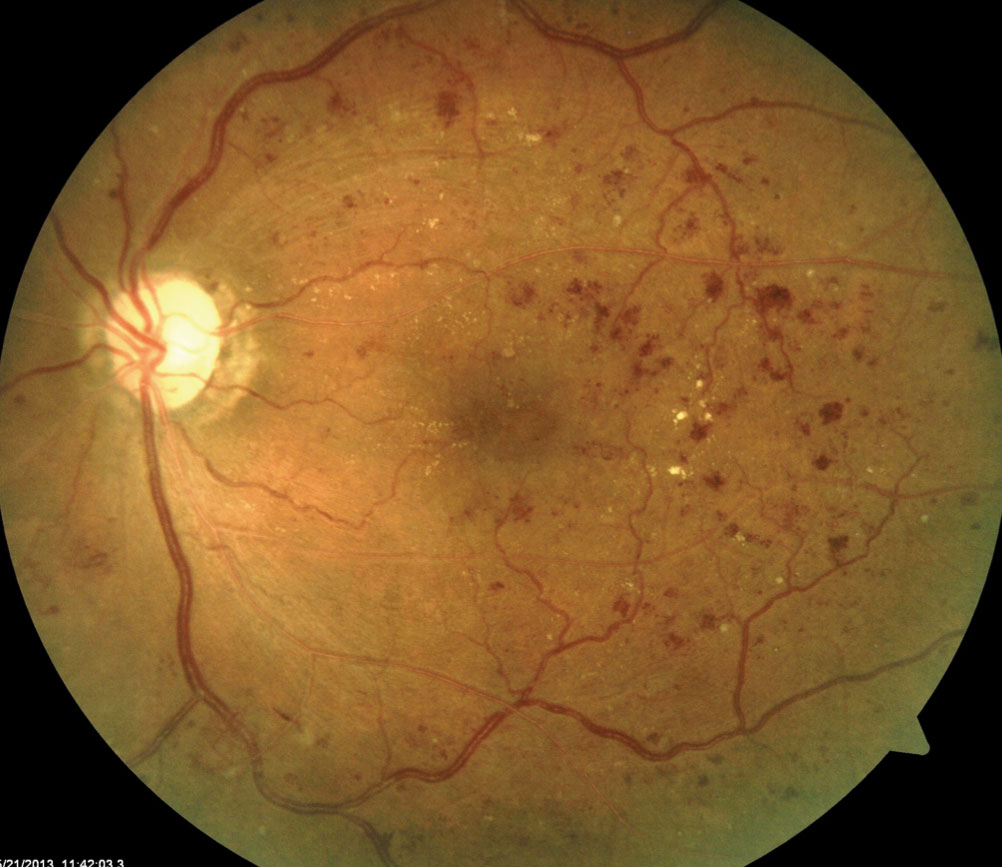 |
| In this study involving more than 4,000 ethnically diverse pregnant women with diabetes in the UK, 65.4% had no retinopathy at 13 weeks, and of those, 74.7% did not develop any retinopathy by 28 weeks. Photo: Mohammad Rafieetary, OD. Click image to enlarge. |
Diabetic screening guidelines for pregnant women have recently been adjusted in several countries in light of new evidence from the Diabetes In Early Pregnancy (DIEP) Study that suggested the number of screenings may be safely reduced in women with no retinal changes early in pregnancy. The study found only a 10.3% risk of progression in these patients compared with a 58% risk of progression in those with moderate non-proliferative retinopathy at 13 weeks pregnant. Additionally, no DIEP study participants with no retinopathy or with only microaneurysms at conception developed proliferative disease.
In response to this new research, the US and Denmark now advise that retinopathy screening beyond early pregnancy may be safely omitted in women without retinopathy as long as they have good glycemic control in early pregnancy. The United Kingdom has yet to change its screening guidelines and still requires at least two visits for women with diabetes during pregnancy, which authors of a new study argue could be “potentially over-burdening an already overwhelmed system.” They add, “It is also important to note that excess screening visits also threaten the emotional well-being of pregnant women, who already face challenges associated with managing diabetes and pregnancy.”
The authors of the retrospective cohort study sought to investigate their hypothesis that for women in the UK with no diabetic retinopathy in early pregnancy, the frequency of retinal screening may be safely reduced. They analyzed the data of 4,718 pregnant women who attended one of three UK Diabetic Eye Screening Programs at 13 weeks gestation (early pregnancy) and 28 weeks gestation (late pregnancy).
The data showed that 65.4% of women had no retinopathy in early pregnancy, and of those, 74.7% did not develop any retinopathy by 28 weeks. Just 14 patients (0.45%) without retinopathy in early pregnancy developed referrable retinopathy by late pregnancy, but no cases required treatment. After controlling for covariates including age, ethnicity, diabetes duration and diabetes type, the researchers found that diabetic retinopathy in early pregnancy remained a significant predictor of diabetic eye screening grade in late pregnancy.
“In this study, no women without retinopathy in early pregnancy developed proliferative disease,” the authors reported in their paper. “The risk of developing the referable disease was very low (0.45%), altogether indicating that repeat screening in late pregnancy may be unnecessary for these women, especially if their other risk factors for progression are controlled.”
The authors conclude by suggesting that in the UK, “current guidance recommending further screening in late pregnancy for these women is reviewed,” considering the present and previous studies’ findings. For women with preexisting diabetic retinopathy in early pregnancy, they maintain that “the risk of disease progression during pregnancy remains significant, and screening of these women should continue in line with current UK guidance.”
Clarke K, Webster L, Althauser S, et al. The risk of development and progression of diabetic retinopathy in a group of ethnically diverse pregnant women with diabetes attending three regional Diabetic Eye Screening Programs in the UK. Eye. July 7, 2023. [Epub ahead of print]. |

